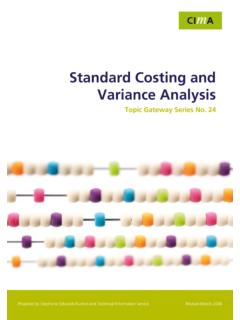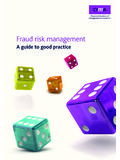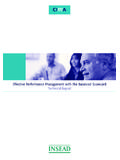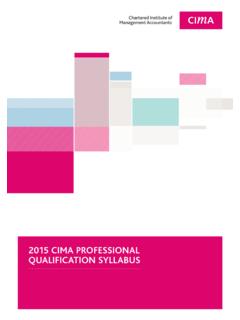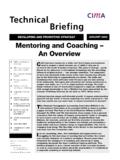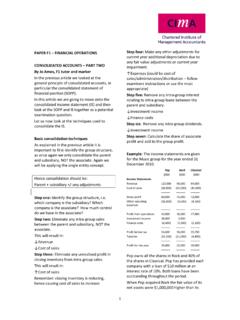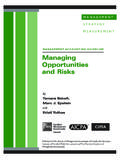Transcription of Theory of Constraints and Throughput Accounting
1 Theory of Constraints and Throughput Accounting topic gateway Series 1 Theory of Constraints and Throughput Accounting topic gateway Series No. 26 Prepared by John Freeman and Technical Information Service March 2007 Theory of Constraints and Throughput Accounting 2 topic gateway Series About Topic Gateways Topic Gateways are intended as a refresher or introduction to topics of interest to CIMA members. They include a basic definition, a brief overview and a fuller explanation of practical application. Finally they signpost some further resources for detailed understanding and research. Topic Gateways are available electronically to CIMA members only in the CPD Centre on the CIMA website, along with a number of electronic resources. About the Technical Information Service CIMA supports its members and students with its Technical Information Service (TIS) for their work and CPD needs.
2 Our information specialists and Accounting specialists work closely together to identify or create authoritative resources to help members resolve their work related information needs. Additionally, our Accounting specialists can help CIMA members and students with the interpretation of guidance on financial reporting, financial management and performance management, as defined in the CIMA Official Terminology 2005 edition. CIMA members and students should sign into My CIMA to access these services and resources. The Chartered Institute of Management Accountants 26 Chapter Street London SW1P 4NP United Kingdom T. +44 (0)20 8849 2259 F. +44 (0)20 8849 2468 E. Theory of Constraints and Throughput Accounting topic gateway Series 3 Definition A technique where the primary goal is to maximise Throughput while simultaneously maintaining or decreasing inventory and operating costs.
3 CIMA Official Terminology 2005 Context Part of CIMA s remit is to review academic research and to highlight the benefits stemming from that research. This recognises the need to support the twin goals of management accountants, namely to create value by reporting financial performance, and by driving financial performance. Experience dictates the latter is much more difficult than the former and is the focus of this report. In the current syllabus, CIMA students will learn and may be examined on this topic in Paper P1, Management Accounting , Performance Evaluation. Overview Managers use cost Accounting to help make decisions to reduce a company s costs and improve profitability . For the sake of completeness, it should be noted that the Theory of Constraints and Throughput Accounting (TOC/TA) is not the only approach used in decision making. Other methods are: standard cost Accounting activity based costing marginal costing. The general hypothesis of TOC/TA is that Constraints are impediments to achieving a firm s goal and their impact reduces profits.
4 Additionally, the hypothesis is based on the supposition that most businesses have very few Constraints , often just one. A constraint can be a resource, a company policy or management mindset. This hypothesis has similarities with limiting factor analysis, which is defined as a factor or condition that impedes meeting goals. Theory of Constraints and Throughput Accounting topic gateway Series 4 The broad concepts Goldratt s ideas on TOC indicate a criticism of traditional Accounting measurement. They focus on working optimally instead. TOC is predicated on there being a finite capacity at certain critical points in any production schedule. By eliminating bottlenecks, TOC increases the velocity of products moving through an organisation and therefore profit is maximised. TOC is not costing as it does not allocate costs to products and services. The TOC approach calculates the product Throughput as the product s sales price minus its material costs. All other costs are taken into account separately as operating costs and are not allocated directly to the products.
5 However, some papers define Throughput as the sales price minus all variable costs. Examples include Noreen et al. (1995) and Gupta (2003). Balderstone and Keef (1999) provide a comprehensive overview of different definitions. Currently, no specific Accounting practices are advocated by Goldratt. Instead, accountants are encouraged to learn TOC ideas and to apply them to Accounting in ways which suit them. The concept of TA was created by management consultants David Galloway and David Waldron. They wished to replace traditional concepts such as direct/indirect cost allocation, economic batch size and treating inventory as an asset. In their view Accounting should monitor the rate at which businesses make money. With this crucial goal in mind, they focused on the return per product per bottleneck hour. Application Goldratt s five steps in the TOC methodology TOC analyses production through a series of steps. Identify the system constraint Is the constraint internal, for example, in production, engineering or planning?
6 Is it external, for example, in the market? Is it a resource or is it a policy? Decide how to maximise the output from the constraint Prepare to subordinate all other activities to this decision. Non- Constraints must be subordinate to the needs of the constraint. Theory of Constraints and Throughput Accounting topic gateway Series 5 Once the resource constraint has been identified, consideration can be given to deploying the appropriate level of resources. As a consequence, the constraint's capacity is increased. Identified policy Constraints can be more easily eliminated Once a constraint has been rectified, go back to step one to identify the next most serious constraint and repeat. In practice reported benefits Standard cost Accounting has lost some of its usefulness recently. Standard cost Accounting aims to identify the variation between actual cost and standard cost. The latter includes volume variation, material cost variation and labour cost variation.
7 Traditionally managers took action to correct costs different from planned through its use. However, cost allocation has become arbitrary and capricious for several reasons and its applicability is now dubious. One reason is that more companies today have common processes for a range of products. The TOC concept avoids cost allocation semantics and restructures the financial control system from one based on reporting entities, such as departments, to a company wide overview of value streams. TOC recognises that some non-critical machines or production facilities will not be used to capacity. Its proponents believe simple recognition is very advantageous because TOC prevents non-critical machines being run to capacity for no purpose if not all their total output can be used. The advantage lies in avoiding the accumulation of the associated excess stocks and work in progress. It also addresses the weakness of managers seeking to optimise production on particular machines if this is sub-optimal for the firm.
8 Markets and customer requirements are constantly changing and the business model must respond quickly. Goldratt s fifth step recognises this requirement. As a pure optimisation tool, TOC can never be better than a correctly formulated linear programming (LP) approach. However, the TOC-based approach has significant advantages over LP. It is easier to use, particularly for managers who are not familiar with operational research methods. Theory of Constraints and Throughput Accounting topic gateway Series 6 TA is an important development in modern Accounting that allows managers to understand the contribution of constrained resources to overall profitability . It also refocuses away from cost Accounting s reliance on efficiencies. TA improves profit performance through better analytical decisions based on three critical monetary variables, namely Throughput , inventory and operating expense. It is sometimes referred to as Throughput contribution and is similar to the concept of contribution in marginal costing sales revenue less variable costs.
9 Supply chains transform components into a finished product that is delivered to the end customer. Goldratt s fundamental rethinking of chain management is best described as a shift from the cost world to the Throughput world . Reported drawbacks TOC and TA detractors' summary of criticisms Specific criticisms have been levelled at TOC and TA and are discussed below: 1. They are short-term decision tools. 2. They may only be valid concepts if applied to the totality of the supply chain including management, production, resources and support. 3. Dependent on circumstances, operating expenses under TOC/TA are regarded as fixed, which is simplistic in the view of detractors. Therefore TOC and TA are basically the same thing as variable costing. Detracting developments The credibility of TOC was seriously debased when Galloway and Waldron discovered a number of difficulties with their TA formulation. They amended their TA departmental performance measures and withdrew TA product costing in favour of an activity based costing (ABC) approach.
10 Since then ABC has been strongly attacked by Goldratt as a fruitless attempt to save the old cost world thinking. Following this spat, it is uncertain where commercial advantage lies. Over the last decade, several papers have been published commenting on the contributions of TOC and TA. Despite complex worked examples, the assessment results of the TOC/TA-based approach in generating optimal work flows are disparate. There is a lack of clarity as to whether TOC/TA is appropriate to provide competitive advantage in a complex and rapidly changing environment. Theory of Constraints and Throughput Accounting topic gateway Series 7 Regulatory financial reporting Traditional costing is premised on Accounting concepts that were designed to satisfy the needs of external and regulatory financial reporting. One example is that the cost of stock is the lower of cost or NRV (net realisable value). Accounting systems for decision making under TOC/TA must have the flexibility to meet these standards.
